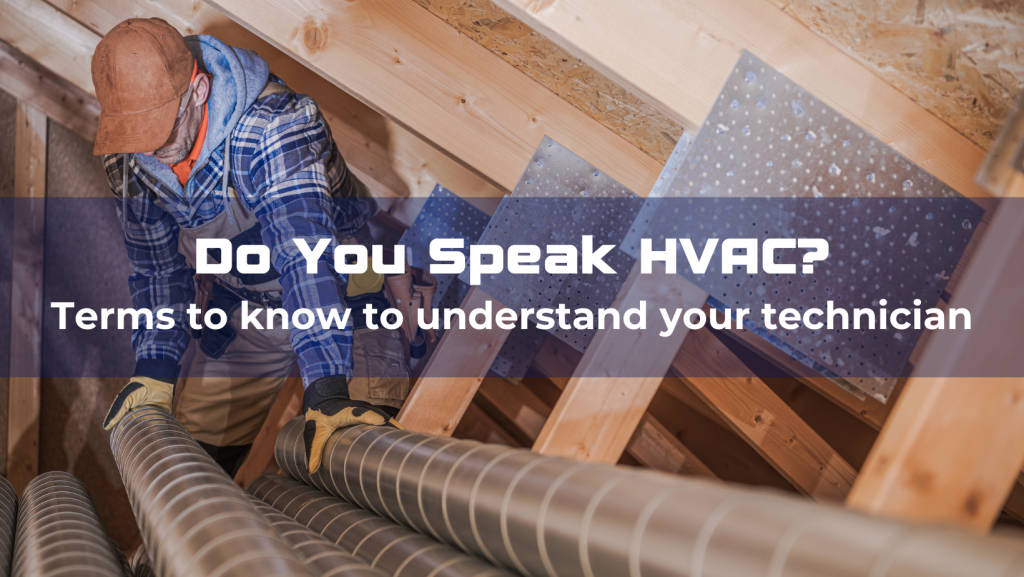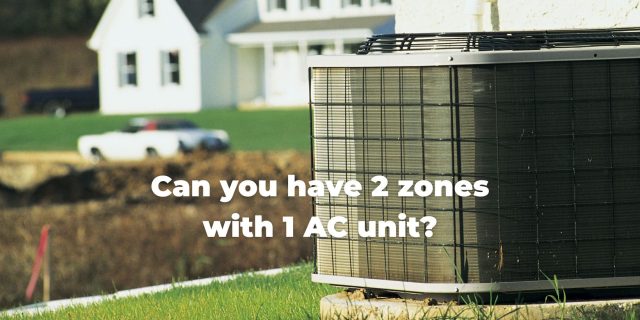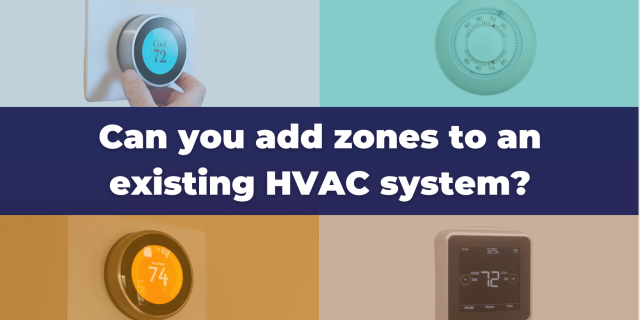
Do you Speak HVAC? Terms to know to understand your technician

Deciding to add, replace or overhaul your HVAC system is stressful enough, but when a contractor comes to your home and starts speaking about Condensing Units, MERV and BTUs, that stress can turn to outright confusion.
Don’t worry; these terms may be familiar to the HVAC Industry but aren’t typically a part of everyday conversation. To help, we’ve compiled the following list of terms and what they mean in “Non-HVAC Professional” terms.
ACCA: The Air Conditioning Contractors of America is a trade organization for HVAC professionals that published standards, offers training and certifications. They also have a database of members that can be a great tool in finding a contractor.
Air Handler – “The Big Box Inside the House” of your HVAC system. Connected to the outside condensing unit, the air handler takes the hot or cool refrigerant and moves air over it, usually with a blower, to send it through the ductwork of your home. It will also have a filter and possibly other IAQ solutions as a part of the system.
Air Return Duct: These ducts send home air BACK to the HVAC system to be reheated, cooled back down, or otherwise circulated. There can be one main return or separate smaller ones, but it must be sized correctly to send back sufficient air for peak system performance.
ASHRAE: The American Society of Heating Refrigeration and Air-Conditioning Engineers is a trade organization that sets standards and helps advance industry research and best practices.
Blower Motor – The component of the HVAC system responsible for moving conditioned air through the system. There can be one main motor, or in the case of air registers, multiple ones.
BTU – Short for British Thermal Unit, it’s the standard method of measurement used for energy. Its actual definition is – “The amount of energy needed to increase the temperature of a pound of water by 1 degree Fahrenheit“. In the HVAC industry, it measures the heating AND cooling power of a system.
Call: This term describes the thermostat activating the HVAC system to heat, cool, circulate or otherwise “turn things on.”
Change-Over: This can have two definitions. With thermostat controls, it refers to more modern units that heat or cool depending on the temperature, instead of needing to be manually switched between “Heating” or “Cooling.” When referencing Indoor Air Quality (IAQ), it means how many times an hour the volume of air in your home is circulated through your HVAC system (here are the ASHRAE standards).
Combustion Chamber: The part of a furnace where fuel is mixed with air and an ignition source to create heat for the system. In a gas furnace, it would be where the pilot light ignites natural gas.
Compressor: Your system’s Compressor takes the vapor refrigerant and applies pressure to it, making it a much hotter fluid. From there, it moves to the Condenser Coils.
Condenser Coil: Taking the hot, fluid refrigerant from the Compressor and slowly reducing the pressure, the Condenser Coils change the refrigerant back to a vapor, cooling it down, and making it ready to move to the Evaporator Coils, where it will cool your home.
Condensing Unit – “The Part Outside” the Condensing Unit is the portion of the HVAC system where the heat is either captured or released, depending on the time of year and system function. It typically has the Compressor, Condenser, a fan, and other controls and can be mounted to the house or on a pad nearby.
Damper: A moveable plate located in the ductwork that can partially or entirely restrict airflow. They are the basis of most zone systems.
Disconnect Box: This is the point in an HVAC System where electrical power can be turned off quickly. Near the Condensing Unit, it is typically outside, is made of metal, and contains a Pull-Out Head that breaks the circuit when removed.
Ductwork: The system of metal or synthetic tubes that carries the treated air through your home. They should be regularly inspected and maintained.
Energy Star – A US Government-backed agency that offers simple, credible, unbiased information on the energy efficiency of various household and business appliances – https://www.energystar.gov/
Evaporator Coil: Located next to your furnace or inside the air handler, the Evaporator Coil is a system of tubes and radiator fins that works to remove heat from your home’s air.
Furnace: The “Big Box” part of the HVAC system is responsible for heating home air, typically with natural gas or electricity. Water-based ones are usually referred to as Boilers, and small, in-line ones are called Heaters.
Heat Exchanger – This is the spot that the “rubber meets the road” in any HVAC system, where air moving through the system is either heated or cooled. Types include – Coil, Radiator Plate, Finned Tube, Duct Plate or Duct Electric, Trench, MicroChannel, Furnace Evaporator, Water Heating Element, Rotary Wheel, Boiler, Pipe, Chilled Beam, or Shell and Tube.
Heat Pump: Utilizing mechanical energy, a Heat Pump removes heat from the air, and either moves it into your system when heat is required or moves it out of your system to cool the air.
IAQ – Indoor Air Quality or IAQ is just what the name implies, but far more complex than it seems. Air circulation and ventilation, humidity levels, building materials, home age, and much more can all affect IAQ. Learn more on this excellent website from the EPA.
Line Set: Also called Refrigerant Lines, they are copper tubes connecting the condenser and the evaporator. Typically one (the liquid or discharge line) is narrower because it carries the refrigerant as a dense liquid, while the other (the suction line) carries it as an expanded vapor. They need to be sized correctly for the system, kept free of kinks or breaks, and should be protected by insulation or line tape.
MERV – Minimum Efficiency Reporting Values, or MERV, is a way of gauging the HVAC filter’s ability to capture air particulates. The higher the MERV rating, the smaller the particulate captured. See the rating system.
Modulating – Modulating HVAC systems adjust the amount of heat produced and air being moved to keep a steady, comfortable temperature. Unlike older systems, which were either “off” or “on,” modulating systems run more efficiently and economically.
NATE – North American Technical Excellence (NATE) is the nation’s largest nonprofit certification organization for HVAC Technicians. You can locate NATE-certified techs here.
NCI – The National Comfort Institute (NCI) is an organization dedicated to helping HVAC professionals grow their business through better service and training.
Neutral Air Balance: This is the ideal state for airflow in each room of your house. Proper design of an HVAC system, with a balanced amount of air coming into a room from vents and an equal amount heading back into the system through return ducts, is the paramount consideration in any project.
Pass-Through Vents – A small duct through a single wall, allowing for air circulation between rooms and leading to better air balance.
Refrigerant Lines – Also called a Line Set, these copper wires (a larger suction line and a smaller liquid line) run from the outdoor unit of an HVAC system to the indoor evaporator coil. The larger line should be well insulated to avoid the loss of cool air.
Return Registers – Usually paired, with one at the ceiling and another at floor level, these registers connect to return ducts and send air back to the HVAC system. They are typically larger than outflow vents and adjustable to optimize airflow depending on the season. They should be kept clean and regularly checked.
Set Point: The pre-set temperature at which your thermostat will “kick on” and begin either heating or cooling your home.
Single & Multi-Stage – A Single Stage HVAC System is either “On” or “Off.” Whether it is heating or cooling, when engaged, it runs at full capacity until the thermostat tells it to stop. A Multi-stage system can run at different levels depending on conditions and adjusts accordingly, increasing comfort and efficiency.
Supply Registers: This is where conditioned air will exit the HVAC system into your home. There should be one per room, and they should have a roller or lever for adjusting the outgoing airflow. DO NOT ever completely close a supply register, as it can significantly impair system performance, efficiency and airflow balance.
Thermostat: The “Brains” of your HVAC system, and one place you will be regularly interfacing with. From old-school dials to remote on-device apps, it allows for multiple levels of control over your home system. Make sure you fully understand the screen(s) on your thermostat(s) and how to maximize the performance of your system. You can take advantage of the most energy savings by following the guidelines outlined by energystar.gov to set energy-saving temperatures on programmable thermostats.
Vent: Also called a Register, these are the metal plates at the end (or beginning) of a duct line allowing for the circulation of treated air through your home. Or – “The metal grate in the floor/wall.”
We hope these definitions and explanations help demystify HVAC for you. For more information you can use, please check out our Blog, or Contact Us.
Topics
- Energy Efficiency (17)
- Homeowner Tips (19)
- HVAC Zoning (25)
- Indoor Air Quality (2)
- Indoor Comfort (32)
- Uneven Temperatures (5)
Recent Posts
View AllEverybody needs to heat and cool their home, and no one likes to pay for it. Even so, most of us are wasting energy to make our homes comfortable. This guide to HVAC zoning will show you how to avoid this pitfall. At the same time, you’ll get better comfort in your home. Imagine lower […]
Creating Multiple Comfort Zones with One AC Unit Can you have two zones with one AC unit? The answer is a resounding yes. With HVAC zoning, you can transform your home into multiple comfort zones, each tailored to your preferences. Instead of relying on a single thermostat to control the entire house, HVAC zoning uses […]
If you’re like most homeowners, you probably look for ways to save money on energy costs. Does HVAC zoning save money? We’ll explore that question here, so you’ll know what to expect if you decide to install HVAC zoning in your home. What Is HVAC Zoning? Let’s start with the basics. When you add zoning […]
Why many homes are uncomfortable Before we ask, “Can you add zones to your existing HVAC system?” it’s helpful to ask why you’d want to do that. Well, without adding zones, you’re left with just one temperature zone for the entire home. There are several issues with this. One thermostat doesn’t give you much control […]



